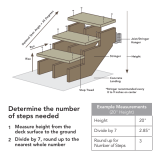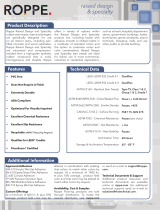
• Left Side. Use the bevel square to ensure you get a tight fit. Slide the bevel square into the left
corner and swivel the arm tight against the stringer then tighten the wing nut to keep the angle.
• Transfer the angle with the bevel square to the new riser.
• Cut the end of the riser with the table saw, angling the blade about 3 degrees so that the new
riser will slide easily into place.
Trim the New Riser:
• Check the existing tread to make sure it is level. If it’s not level, you’ll need to pad the new tread
to become level; therefore, changing the height of the new riser
• Measure the height in three (3) locations: Right, Center and Left (just in case there’s a slight dip
in the existing riser).
• Set the table saw’s rip fence to the measurement and cut the new riser’s height so that the new
tread will sit level.
Install the New Riser:
• Use the caulk gun to apply construction adhesive over the entire back of the riser (Note: To keep
the adhesive from seeping out of the edges, do not apply the adhesive too close to the edges).
• Place the riser into position.
• Use a scrap piece of wood to tap the new riser until it is snug against the existing rise.
• Tap the riser down to make it snug against the floor.
Install the New Tread:
• Check how square the intersection of the tread and stringer is. If the intersection is not square,
use a scrap piece of cardboard to make a template.
If a side is not square:
• Place a small straight edge on template and transfer the line to the cardboard with the straight
edge snug against the stringer.
• Place the template on the new tread and line up the square side with the same side of the tread.
• Transfer the line back to the tread by placing the straight edge in the same location but draw your
line on the outside.
• Cut the tread with the table saw. To ensure a tight fit, cut the tread a little long with the table saw
and use a belt sander to bring the cut right up to the line.
• Use the caulk gun to apply the construction adhesive over the entire back of the tread.
• Place the tread into position.
• Use a scrap piece of wood to tap the ends of the tread into place (this ensures no hammer marks
and that that the ends of the treads do not chip).
• Position the tread front-to-back to make sure the overhang is consistent, and make sure you hit
the mark you made earlier on the stringer.
• Pre-drill a hole on the back of the tread on either side.
• Use a hammer to secure a nail in the tread to hold the tread into position while the glue dries.
Next Steps:
Start from the bottom and work up until you complete your set of stairs!







